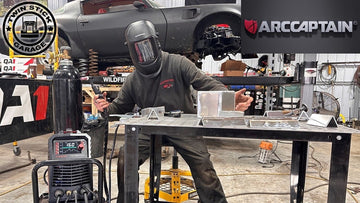
TIG welding, known for its precision and cleanliness, utilizes a tungsten electrode to produce the weld. This method is highly favored for its ability to weld a wide variety of metals without generating spatter or significant smoke. Today, we're delving deep into the intricacies of TIG (Tungsten Inert Gas) welding, exploring its advantages, techniques, and some hands-on tips that can significantly enhance your welding skills. The welding machine used in this teaching session is the ARCCAPTAIN TIG200P.
Features and Functionality
The TIG200P operates on both AC (Alternating Current) and DC (Direct Current), making it suitable for welding not only steel and stainless steel but also aluminum. The inclusion of square wave inverter technology is a significant upgrade, allowing for precise control over the AC balance and improving the quality of welds on aluminum.
One of the remarkable aspects of the TIG200P is its user-friendly interface. It includes intuitive controls for adjusting parameters such as amperage, AC balance, and pulse frequency, which are crucial for managing the heat input and weld bead characteristics. This makes it ideal for both beginners and seasoned professionals looking to refine their technique.
For detailed introduction of various TIG parameters, please watch this video.
Practical Welding Lessons and Tips
In our comprehensive guide to mastering TIG welding with the TIG200P, we delve deeper into practical lessons and tips that will help both novices and experienced welders refine their skills. Here’s an expanded look at the hands-on experiences, techniques, and nuances of TIG welding that we explored during our session.
Getting Started with Steel
For those new to TIG welding, starting with steel is advisable. Steel is forgiving and a great material to practice achieving consistent bead appearance and heat control. During our session, we practiced adjusting the amperage and experimented with the foot pedal, which allows for real-time control of the heat input during the welding process. Beginners should focus on maintaining a steady hand and consistent travel speed to ensure even welds.
Exploring Aluminum Welding
Aluminum welding with the TIG200P is facilitated by its AC capability, which is crucial for cleaning the oxidized layer on aluminum before the weld puddle is formed. We adjusted the AC balance to control the cleaning effect versus the penetration, finding a sweet spot that allows for clean, strong welds. For aluminum, the use of a higher frequency setting helps stabilize the arc and refine the bead profile.
Pulse Welding Techniques
Pulse welding is a standout feature of the TIG200P, allowing for better control over heat input, which is especially beneficial when working with thinner materials or when precision is paramount. By setting the machine to pulse, the welder alternates between a high peak current and a low background current. This technique reduces overall heat input, minimizes warping, and can improve the appearance of the weld. During our test, we adjusted the pulse frequency and observed how different settings affected the weld pool dynamics and bead characteristics.
Advanced Controls and Settings
The TIG200P offers a range of settings that can be fine-tuned for specific welding needs. We explored the AC balance for aluminum, adjusting how much time the current spends in each phase of the cycle to manage cleaning action and penetration depth. We also experimented with the post flow control, which governs how long the gas continues to flow after the arc stops, protecting the weld as it cools.
Real-World Applications and Problem Solving
In a practical scenario, we simulated a repair task on a thin metal sheet, a common challenge in automotive repairs. By adjusting the welder to a lower amperage and using a triangular wave for a sharper, less penetrating arc, we were able to make precise welds without burning through the metal. This setting is particularly useful for automotive enthusiasts looking to repair body panels or create custom parts.
Tips for Continuous Improvement
1.Practice Consistency: The key to mastering TIG welding is consistency in your technique. Regular practice on scrap materials will help develop muscle memory for torch and pedal control.
2.Material Preparation: Always ensure your material is clean and properly prepped before welding. This is especially important for materials like aluminum, which oxidize quickly and can contaminate the weld.
3.Watch and Learn: Observing the behavior of the weld pool and learning to adjust your technique in real-time based on what you see is crucial for advancing your skills.
We also explored the pulse welding feature, which is invaluable for reducing heat input while improving the aesthetics of the weld bead. Pulse welding is particularly useful when working with thin materials or intricate parts, as it helps prevent warping and burn-through.
Safety and Maintenance
Welding, while rewarding, poses its own set of risks. It's imperative to use the provided protective gear and to ensure that the welding environment is safe and well-ventilated. Regular maintenance of the welder is also crucial to ensure its longevity and performance. The TIG200 Pro’s design facilitates easy access to consumables and parts that might need regular replacement, like the tungsten electrode and shielding gas nozzles.
Conclusion
The TIG200P represents a significant advancement in TIG welding technology, offering portability, power, and precision in a compact package. Whether you're a hobbyist looking to craft perfect welds on a motorcycle frame or a professional tackling a complex fabrication project, the TIG200P offers the capabilities and comfort needed to achieve high-quality results. For those eager to enhance their TIG welding skills, investing in a machine like the TIG200P and spending time practicing different techniques and settings is key. Remember, like any craft, TIG welding requires patience and practice to master.
